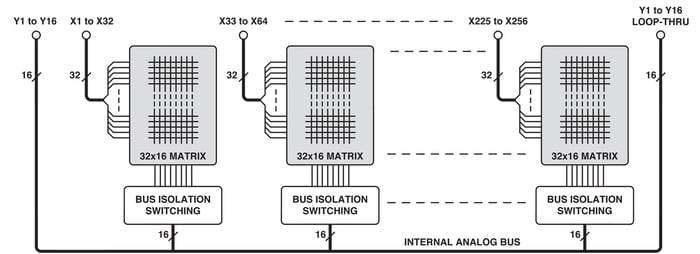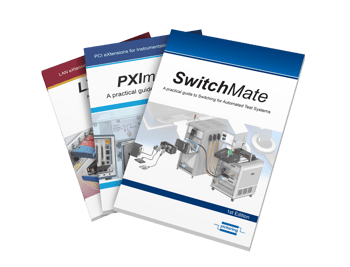The Differences Between PXI and LXI For Switching in Electronic Test
Switching systems that route instrumentation and stimulus signals to appropriate test points on a unit under test (UUT) are crucial in most automated electronics test systems. Sharing test resources, the connection of calibration references, load management, and many other functions are managed by the switching system. The switching system is the interface between the unit under test (UUT) and the test equipment.
You have a choice in which platform you use to control switching. For us, the principal platforms are PXI and LXI. Let's dive into the background of these two.
A Brief History
PXI, short for PCI eXtensions for Instrumentation, is a rugged PC-based platform that offers a solution for measurement and automation systems. With PXI switching, you benefit from the low-cost, high-performance, and flexibility of the latest PC technology and the benefits of an open industry standard. PXI standard has proven to be an excellent basis for modular switching products and instrumentation. Product development speed can be high, enabling a large variety of standard and custom switching solutions to be made available in response to user demand.
More information on PXI can be found in our PXIMate eBook or on the PXI Systems Alliance website.
The PXI standard is well-established and has been widely adopted in the testing industry as the preferred modular platform for automated test applications. While it offers a fast communication interface to support applications requiring the exchange of large blocks of data needed for analysis by the system controller, it also imposes mechanical and power restrictions on the modules, putting a boundary on the applications that can be efficiently addressed. Additionally, systems architects may not want their instrumentation or switching products to be extensions of their PC's PCI bus or may not want the switching portion of their test system in the same chassis with the instrumentation because of possible electrical noise. They may opt for the convenience of a different communications interface to their instruments. Although it has been hugely successful, PXI has not permanently displaced many of the rack or bench instruments that require more power or design real estate than the PXI platform offers.
LAN/Ethernet has been adapted as the most common communications interface for rack or benchtop test instruments. Ethernet connections are omnipresent on all modern system controllers. The connection cables are easily managed, have a latching mechanism and virtually no restrictions on distance or the number of instruments supported. The industry standard for control of test instrumentation via the Ethernet interface is LXI, short for LAN eXtensions for Instrumentation. The LXI standard enforces compliant instruments to implement the Ethernet control in a standardized way, eliminating the concerns about implementation conflicts on the Ethernet connection that could arise on proprietary implementations. There are also no restrictions on power or mechanical size of a device with an LXI interface; an LXI-compliant instrument can be as large and consume as much power as the application it is addressing dictates.
More information on LXI can be found in our free LXImate eBook or on the LXI Consortium website.
Standardizing LAN connections for instrumentation was a significant leap forward. The adoption of LXI as an instrumentation communications interface has been rapid; Like PXI, the LXI standard is well-established and stable. LXI devices that conform to the first version of the standard still work with the devices conforming to the latest version.
General Comparison of PXI vs LXI
PXI and LXI are not competing standards—though, in some applications, they will have similar characteristics. In others, there are apparent differences—and that can mean that one platform is more suitable than another. The test and measurement industry considers PXI a modular platform and LXI a communications interface for rack/box instruments. However, it is essential to note that since the LXI standard does not focus on a common mechanical definition, it does allow for modular implementations. LXI modular devices are generally proprietary, unlike PXI, where strict mechanical/electrical definitions result in multi-vendor interoperability.
While LXI can support 1 Gbps block transfer rates, PXI (PXI Express) implementations can support 24 GB/s transfer rates. Systems engineers who need to develop complex data processing algorithms in an application on the host PC value the speed at which the PXI interface can transfer data from the instrument to the controller. An LXI instrument will transfer data blocks to the host controller or perform the data processing within the instrument itself. Because it is LAN-based, it is also ideally suited for distributed applications where data is passed between multiple devices separated by significant distances.
As alluded to earlier, the PXI standard's fundamental objective is to permit products from different vendors to co-exist in a chassis. Otherwise, it fails to meet the market expectation and the objectives stated in the standard. That means that a chassis, and indeed the software infrastructure, must operate with potentially many different types of modules (instrumentation or switching) in the same chassis. The chassis design must meet all PXI vendors' expectations, requiring the defined minimum requirements set out in the PXI standard.
Choice of Chassis
The PXI chassis can be complex since the PXI standard has evolved into two distinct backplane control interfaces—PCI and PCIe. PCI is a parallel bus structure, and PCIe is switched serial. PXI chassis provide slots that support modules that have a PCI bus interface while PXI Express (PXIe) chassis can provide slots that are either exclusively for modules that are PCIe based, support both PCIe and PCI based modules (referred to as ‘hybrid’ slots), and PCI based only slots. Since most PXI products in today’s market have a PCI-bus interface, many systems engineers select chassis that provide the maximum number of hybrid slots, so they have greater flexibility in their instrumentation selection. If a chassis is selected that reserves slots specifically for PCI or PCIe module types, then care will need to be taken to ensure that the modules you require are available in the interface available on the chassis backplane.
Most LXI instruments are fully integrated, single-purpose devices (e.g., an oscilloscope). However, some vendor-specific modular LXI architectures provide systems engineers with the flexibility to construct a multi-function instrument with an Ethernet interface. In some cases, vendors will offer chassis with different slot counts to promote a scalable architecture.
Applying to Switching
For switching, speed differences are of little consequence. In practice, the speed of change of switching systems is constrained by mechanical components (relays)—even solid-state switching does not need the multi-gigabit speeds of PXIe. Generally speaking, the mechanical and electrical constraints of PXI can influence what can be cost-effectively supported in PXI. Still, on the other hand, the fact that it supports multiple vendors modules and can easily integrate a diverse range in functionality can result in a more compact system than that which can be constructed with box instruments with an LXI interface.
As ever, one standard does not fit all. LXI offers the greatest design freedom, while PXI offers a means to integrate small modules from multiple vendors into an open standard chassis. Not surprisingly, that means both have their place, and both standards can claim circumstances under which they might perform better than the other for switching and other applications.
There is a clear distinction based on size. For example, if a sizable matrix is required, LXI will often be the better choice. PXI can be used to implement these large systems, but the PXI chassis cost, cable interconnect cost, and software complication of implementing a large switching function over many modules increases the system cost, decreases its performance, and adds complexity to the system control and programming time. A matrix created from multiple PXI modules that are cable connected is controlled as separate modules, not as a single matrix.


LXI products like our 60-554 high-density matrix integrate multiple sub-assemblies into a single matrix in preference to using separate matrices
with connecting cables with the user having to control each sub-matrix independently.
Finally, since signal switching requirements often cover a broad power/frequency spectrum, it is common for systems engineers to specify modular switching platforms for their ATE designs. In fact, it is safe to say that most switching solutions are being designed around modular platforms. In addition to providing a framework for multi-function capability, a modular switch system can also be easily repaired in the field. And since PXI (by definition) and LXI (depending on the vendor) offer modular architectures, there are quite a few options from which to choose.
Summary
There is no "best" platform for signal switching in automated test systems; the LXI and PXI standards bring different advantages and disadvantages depending on what you may be trying to do. In this respect, instruments are also not that different—there are always examples where PXI and LXI implementations will have different compromises on cost, performance, and size. Vendor-designed enclosures usually convey performance advantages to LXI solutions; a modular chassis system can offer advantages in cost and size for diverse systems, mainly where the functions are diverse and high levels of multi-vendor integration are required.
So, there is a broad spectrum of possibilities open to you. For companies like us who embrace both the LXI and PXI standards for our core products, it is very much a question of letting you, the user, decide the most appropriate solution for your application rather than forcing you to use a particular platform.
Want to learn more about PXI and LXI for use in switching? Check out our free eBooks—LXImate and PXImate. And for more information on switching in general, download our SwitchMate eBook.

